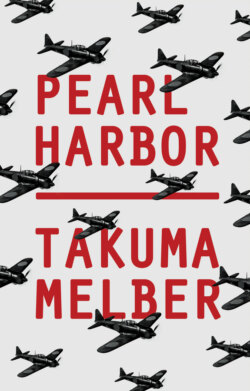Pearl Harbor

Реклама. ООО «ЛитРес», ИНН: 7719571260.
Оглавление
Takuma Melber. Pearl Harbor
Contents
List of Figures
Guide
Pages
Pearl Harbor. Japan’s Attack and America’s Entry into World War II
Dedication
Prologue
Note
1The Background. The road to Pearl Harbor
The crisis intensifies
Japan’s proposals for resolving the conflict
The Hull Note
Notes
2The Japanese War Plan. Admiral Yamamoto and Operation Hawaii
The plan of attack
The Kidō Butai sets sail
Japanese spies on Hawaii
The first encounter
Notes
3The Attack. The first wave
“Tora Tora Tora”
Battleship Row in crossfire
The second attack wave
Egusa’s dive bombers
Notes
4Consequences. The aftermath
The USA enters the war
The first prisoner-of-war
The Japanese-American victims of Pearl Harbor
Could Pearl Harbor have been prevented?
Conspiracy theories
Operation K
Notes
Epilogue
Notes
Select Bibliography
Index
A
B
C
D
E
F
G
H
I
J
K
L
M
N
O
P
R
S
T
U
V
W
Y
Z
POLITY END USER LICENSE AGREEMENT
Отрывок из книги
Takuma Melber
Translated by Nick Somers
.....
Akamatsu’s plane broke through the cloud cover. In the distance he could see the island of Hawaii the pilot was steering towards. The hour had come that would bring Japan glory and honor. The message from Admiral Yamamoto Isoroku passed on at the briefing by the fleet commander still resounded in his ears: the attack on Pearl Harbor would determine the survival or destruction of the entire Japanese nation. If the plan – which was completely reliant on the element of surprise – were to fail, the war would be lost before it had even started.
Akamatsu and the men in the first Japanese attack wave were aware of the significance of their mission: the surprise attack had to succeed at all costs. As they overflew the coast of the main Hawaiian island of Oahu, the bomber squadron maneuvered into formation and headed directly for its target, Pearl City harbor, and the US Pacific Fleet anchored there. Just a few moments after the Japanese navy airmen had spotted the main US navy base in the Pacific, Akamatsu received a signal informing him of their target, the Tennessee-class destroyer USS California, commissioned in 1921. Before Akamatsu knew it, the pilot was diving towards the majestic-looking enemy vessel. When the steel colossus came into his sights, he pressed the button at just the right moment, as he had learned through the months of training, to release the deadly torpedo. At that moment the plane came under heavy anti-aircraft fire. Akamatsu felt as if the US fleet, which had been taken completely by surprise, was directing all of its anti-aircraft fire at him and his plane. While the pilot ascended desperately in an attempt to dodge the hail of bullets, Akamatsu heard a loud explosion, and a blast wave passed through his body. Or was he imagining it? When the plane was finally out of the danger zone, Akamatsu looked back at the scene from a safe altitude. Black smoke was billowing from the USS California; he was fairly certain that the torpedo had found its target and penetrated the ship’s hull. Akamatsu and his comrades had accomplished their mission. The crew were overwhelmed with a feeling of euphoria and spontaneously cried out a triumphant “Tennō Heika Banzai!” – Long live the Emperor of Japan! Akamatsu proudly set course for the aircraft carrier Kaga.
.....